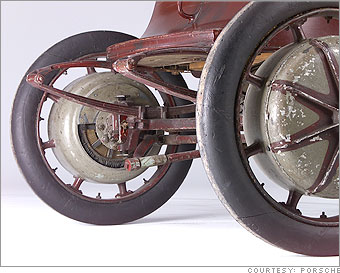Nov. 11 2007

Next to its new Porsche Cayenne Hybrid SUV at the 2007 Los Angles Auto Show later this month, Porsche will show off an electric car from 1900 designed by founder Ferdinand Porsche. This is the predecessor of what was the world’s first hybrid car, which followed this one by just a few years.
Even Porsche’s initial all-electric design was revolutionary, despite the fact that electric cars were fairly common (insofar as any automobile was common) at the turn of the last century. Porsche’s electric car was named “most innovative invention” at the Paris World’s fair in 1900, notoriety that resulted in the sale of over 300 of the cars.
Ferdinand Porsche’s first great fascination as an engineer wasn’t with automobiles but electricity. As a youngster, he experimented secretly at home with electricity, and his first engineering job was with an Austrian company that made electrical equipment.
It was there that he was asked to engineer an electric motor that had been requested by Austria’s royal carriage manufacturer, Jacob Lohner & Co. The electric motors were to be housed within the carriage’s wheels.
After he completed the motor design in 1898, Porsche was hired by Lohner to work on the carriage that would run on the motors.
With an electric motor in each front wheel, the car had a top speed of about 31 miles per hour. Versions of this car won several races, often with Porsche himself at the wheel.
One racing version, created in 1900 and capable of a top speed of 37 miles per hour, had electric motors in all four wheels, allowing Porsche Cars to claim that its founder created the first all-wheel-drive vehicle.
What made Porsche’s electric car so revolutionary was the manufacturing simplicity and energy efficiency engendered by placing the motors directly at the wheel hubs.
With no transmission or cables of any sort needed to carry energy from the motors to the wheels, 83 percent of the energy used by the car actually went to move the car. That compares to less than 20 percent for modern internal combustion engines.

Despite that, Porsche’s electric car design was severely limited by the available battery technology. Batteries couldn’t hold enough electricity for long trips, and they wore out quickly. Adding more power and range meant adding lots more weight.
Battery power also made the cars quite expensive. Typical buyers were wealthy industrialists like Emil Jellenik, the Daimler Motor Co. investor who demanded that that company name its cars after his daughter, Mercedes.
Hybrid power
Porsche’s answer was to generate electricity on-board as the vehicle drove. By 1901, he added a gasoline internal combustion engine to one of his all-wheel-drive electric race cars creating, essentially, the world’s first hybrid car.
Unlike most hybrid cars today, the Lohner-Porsche Mixte’s gas engine never powered the wheels directly. It was only used to generate power for the car’s electric motors. In that way, it’s more similar to something like General Motor’s Chevrolet Volt concept vehicle. One big difference is that the Lehner-Porsche was, ultimately, powered by gasoline alone. It couldn’t be plugged in for extra charging.
All five hybrid cars produced in 1901, equipped with Mercedes-Benz engines, were bought by Emil Jellinek. With further development, the Porsche-Lohner hybrids reached top speeds of 56 miles per hour.
As far as today’s Porsche is concerned, the company is searching for ways to adapt to stricter fuel economy rules expected to come soon to the United States and Europe.
While a hybrid system will work in an SUV like the Cayenne, Porsche executives have said, the company’s core remains its sports cars. It would be difficult to make a hybrid sports cars that would retain Porsche’s legendary handling and balance, Porsche North America chief executive Peter Schwarzenbauer said in a recent interview with CNNMoney.com.





